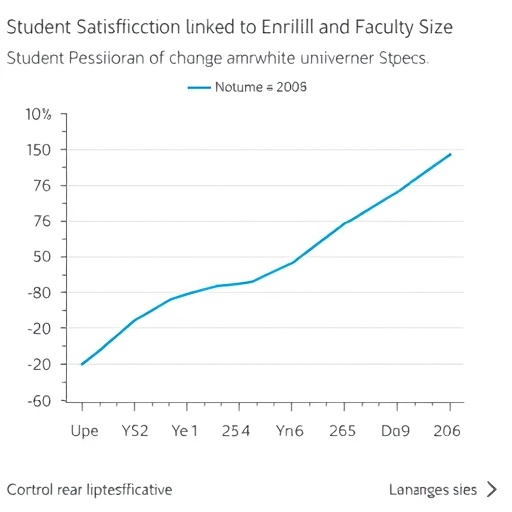In recent years, the landscape of higher education has witnessed dynamic changes, significantly influenced by various factors such as student demographics, institutional strategies, and educational standards. The concern for student satisfaction has become pivotal to the success of educational institutions worldwide. A recent study conducted by Kilby et al. investigates the intricate relationship between student satisfaction and the sizes of both student and staff populations in higher education settings.
As the study unfolds, it reveals compelling insights into how these two variables interact—highlighting the implications for educational policy and practice. The core finding of Kilby and colleagues is rooted in the notion that larger student populations do not inherently correlate with decreased student satisfaction. Rather, it’s the relationship between the size of student bodies and staff availability that creates a nuanced picture based on individual institutional contexts.
The researchers meticulously gathered data from a diverse range of higher education institutions, capturing student satisfaction metrics correlating with varying student-to-staff ratios. This aggregation is pivotal in understanding the complexities of educational engagement and satisfaction levels among students. By leveraging comprehensive statistical analysis techniques, Kilby et al. were able to disentangle direct relationships and identify trends that could inform future educational strategies.
One critical aspect of the research highlights the importance of accessibility to staff and faculty members. Institutions that demonstrated a higher ratio of staff to students typically observed improved satisfaction rates. This is indicative of the essential role that faculty engagement plays in the educational experience, where direct interaction with staff is a cornerstone of satisfaction. The study suggests that institutions must strive to maintain optimal ratios to foster environments conducive to academic success.
Interestingly, size dynamics also play a significant role in shaping the educational experience. For example, smaller institutions tend to foster closer-knit communities, which can enhance overall satisfaction. Conversely, larger universities may offer a broader range of programs and resources, presenting unique opportunities for students. It suggests that the ideal balance is institution-specific, and a one-size-fits-all approach may not serve the interests of diverse student populations.
Furthermore, the study emphasizes that student satisfaction is influenced not only by quantitative metrics but also by qualitative experiences. This brings to light the significance of curricular offerings, extracurricular activities, and support services, all of which contribute to a student’s feeling of belonging and value within an institution. The narrative crafted by Kilby et al. suggests that institutions must actively engage with student feedback to understand their unique needs and expectations better.
The research also touches on technology’s role in higher education, particularly in hybrid and online learning environments. With increasing reliance on digital platforms, students have different expectations regarding interaction and support. The adaptability of staff to switch between traditional and digital engagement models can dramatically impact student perceptions of satisfaction. As educational methods evolve, so too must the strategies employed by staff to meet the shifting dynamics of student needs.
Recruitment practices also became a focal point in the findings. Institutions that prioritize hiring faculty who are not only qualified academically but also have a passion for mentoring and student engagement tend to foster higher satisfaction rates. This holistic approach to recruitment emphasizes the importance of cultivating an educational environment that does not solely focus on academic accolades but also prioritizes student experience and personal growth.
Moreover, there exists a complex interdependency between staff morale and student satisfaction, as discussed in Kilby et al.’s findings. A satisfied and motivated staff is more likely to produce positive educational outcomes and, by extension, a satisfactory student experience. This interrelationship underscores the necessity for institutions to invest in professional development and workplace satisfaction initiatives aimed at academic staff.
Understanding the landscape of student satisfaction also requires a deep dive into individual student attributes, including personal goals, expectations, and prior educational experiences. Different demographic factors—including age, background, and career aspirations—inevitably shape how students perceive their educational experiences. The study suggests that institutions should, therefore, consider these variances and tailor their approaches to accommodate a diverse range of students.
As conversations around higher education continue to evolve, the findings from Kilby and his colleagues serve as a critical lens through which institutions can assess their strategies, particularly in light of recent global challenges. The COVID-19 pandemic has created an urgency for institutions to rethink how they engage with students and how they can ensure satisfaction amidst the uncertainties of the future.
Essentially, the research provides a roadmap for institutions looking to optimize their educational offerings, emphasizing that a laser focus on student and staff ratios should be part of a broader strategy that includes engagement, satisfaction, and quality assurance. The implications of these findings extend beyond mere statistics; they speak to the heart of what higher education seeks to achieve—a conducive environment for learning, growth, and satisfaction.
As the realm of higher education continues to shift and adapt, the insights presented by Kilby et al. emphasize an increasingly nuanced understanding of satisfaction metrics. In a world that is ever-evolving, understanding and responding to the diverse needs of students and staff alike will be essential for institutions that seek to thrive in an increasingly competitive landscape.
In conclusion, Kilby and his team’s work not only underscores the importance of the complexities in interpreting student satisfaction, but it also calls for a deeper examination of the relationships that govern educational environments. As institutions navigate future challenges, the critical lessons learned from this research may well steer educational policy and practice toward more mindful and effective strategies aimed at fostering satisfaction for all stakeholders.
Subject of Research: The relationship between student and staff sizes and student satisfaction in higher education.
Article Title: Student satisfaction as a function of student and staff sizes in higher education.
Article References: Kilby, C.J., Nicoll, C., Coburn, J. et al. Student satisfaction as a function of student and staff sizes in higher education. High Educ (2025). https://doi.org/10.1007/s10734-025-01569-y
Image Credits: AI Generated
DOI: 10.1007/s10734-025-01569-y
Keywords: student satisfaction, higher education, staff size, student size, educational policy, engagement, demographics, online learning.




